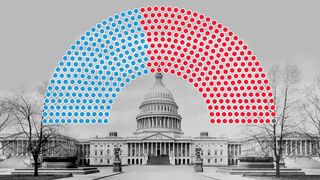The United States midterm elections are being held on Tuesday, 6 November. This offers the first nationwide referendum on the presidency of Donald Trump.
Presidential elections are held every four years, in conjunction with votes for congress, state governors and other positions. Midterm elections are held half-way between presidential elections (in the middle of a four year presidential term, hence the name).
The national component of the midterms – the vote for Congress – is what receives the most attention. All 435 seats in the House of Representatives are contested every two-years and a third of Senate seats every six-years (so a third of the Senate is elected with the House every two years). Congress is similar to our federal parliament. Along with other roles, support of both Houses of Congress are required for legislation to become law.
Australia and the 2018 US midterm elections: A primer

Each state is represented by at least one seat in the House, with additional seats allocated by population. California has the most, with 53 seats. Montana, Wyoming, Vermont, and North and South Dakota have the least, with one each. The Senate has 100 senators with two from each state irrespective of the size of the state.
Votes are also held for several state and local positions. In 2018, elections for governors will be held in 36 states and 3 territories (these are like Australian state premiers). Legislative elections are held in 46 states and 6 territories (these are like our state parliaments). There are local mayor and municipality elections which also occur on the same day in cities, towns and counties across the country, including in San Francisco, Washington DC and Nashville.
In addition there are numerous local ballot initiatives in some parts of the country where voters decide on specific policy questions. These include referenda to change laws, or bond measures that allow (usually) local governments to borrow money to fund new services and infrastructure projects.
What is the likely outcome?
At present the odds are nearly 75 per cent that Democrats will gain control of the House. Generic ballots put the Democratic share of the congressional vote at nearly 49 per cent, and the Republican share at 40 per cent. Because Democrats currently hold a majority of the 35 seats up for grabs in the Senate – including 10 in states won by President Trump in 2016 – they may go backwards in that chamber.
However, the actual outcome will be shaped by a number of factors. This includes gerrymandering (by both sides, but most egregiously by the Republicans since 2010); Democratic concentration in several large cities, which means they win big in a few places (California, New York, Massachusetts), but narrowly miss out elsewhere even when they do well; and perhaps the quality of candidates and the amount of money raised and spent on campaigns.
What do the midterm elections mean for the United States?
The midterms present an opportunity for voters to either allow Republicans to continue to control both the executive and legislative branches of the US federal government, or place a check on the Trump administration.
Despite holding 51 seats in the Senate, plus a majority in the House of Representatives and controlling the presidency, Republicans have had trouble moving their legislative agenda forward. Part of their problem lies in the Senate. Their majority in this chamber is narrow. When two or more Republican Senators vote with the Democrats (which does happen), they fail to pass legislation. Further, the curious institution of the filibuster provides individual Senators with the power to hold up Senate proceedings.
If the Republicans can expand their Senate majority (most realistically by winning the 10 Democratic seats in the states won by Trump), it will make it easier to obtain a simple majority. If they can expand their majority to 60, they can overrule the filibuster in most instances. Combined with a majority in the House of Representatives and a Republican in the White House, this would allow them to pass any legislation they wanted.
However, even if Republicans expand their margin in the Senate, it is unlikely this will grow to 60. They may even go backwards. Besides hampering the Republican legislative agenda, this would have other effects. Unified Republican control has allowed President Trump to appointment numerous conservative judges to federal courts, which play an important role in the American system of government. A Democrat Senate would be able to approve or reject the President’s judicial appointments.
Republicans may also lose the House. Along with the ability to pass or reject legislation, a Democratic House or Senate would control each chambers’ committees.
These are important centres of power in Congress. They handle legislation and are watchdogs over the presidency and government departments and agencies. The chair of each committee and a majority of their members are from the majority party in each Chamber.
Ongoing control by Republicans would allow them to continue to set the policy agenda in Washington. A Democratic majority would allow that party to hold hearings into the Trump administration, calling witnesses to testify before the committee and gathering evidence (including Donald Trump’s elusive tax returns). Control of Congress could even allow the Democrats to begin impeachment hearings in the president, which could result in Donald Trump being removed from office; although the chances of this actually happening may be remote.







